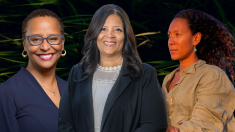“A teenager is dead. He is dead through no fault of his own. He is dead because another man made assumptions. That man assumed certain things. He’s dead not just because the man made those assumptions, because he acted upon those assumptions. And unfortunately, unfortunately because his assumptions were wrong, Trayvon Benjamin Martin no longer walks on this earth.”
With these powerful words, prosecutor Bernie de la Rionda began two hours of closing arguments on Thursday during which he painted George Zimmerman, the 29-year-old neighborhood watch volunteer who faces second-degree murder and manslaughter charges in the fatal shooting of Martin, who was unarmed, on February 26, 2012, as a “wannabe cop” who was “sick and tired” of criminals in his community and profiled Martin, 17.
But, de la Rionda argued, "Trayvon Martin was there legally, he had not broken in, sneaked in or trespassed. He went to a 7-Eleven. What was his crime? He bought Skittles and some kind of watermelon iced tea. He was minding his own business but apparently this defendant decided he was up to no good.”
Using Zimmerman’s own words, de la Rionda recounted, one by one, the many inconsistencies and lies that he told police officers in a videotaped statement about the altercation. For example, Zimmerman claimed he wasn’t following Martin but was looking for the name of a street in the Retreat at Twin Lakes, the gated community in Sanford, Fla. where the shooting occurred, even though there were only three streets and he had lived there for several years.
“If he's not doing anything wrong in following an individual, why does he have to lie about it?" de la Rionda asked.
Zimmerman also claimed that Martin suddenly appeared and sucker punched him in the nose. But in the video, de la Rionda said, Zimmerman quickly caught himself and backtracked, telling police, “When I walked back toward him … I saw him coming toward me,” in an attempt to make Martin seem like the aggressor, the one who approached him.
In addition, Zimmerman told investigators that Martin, at one point, had his hands over his mouth and nose, and reached for his gun, all at the same time.
“How many hands did Trayvon have?” de la Rionda asked. “He's holding one hand over his mouth, one hand over his noise, and with that third hand he reaches for the gun?”
Zimmerman, de la Rionda said, was “caught in numerous lies” and exaggerated the circumstances surrounding the encounter and his own injuries. Though Zimmerman claimed Martin broke his nose, and repeatedly slammed his head against a concrete sidewalk, the prosecutor pointed out that there was no blood on Martin’s hands or DNA under his fingertips.
“Blood on the defendant stayed, but blood on Trayvon Martin just sort of vanished?” he asked.
The prosecutor also shot down Zimmerman’s claim of being in fear.
“Why does the defendant get out of his car if he thinks Trayvon Martin is a threat to him?” de la Rionda asked. “Because he has a gun. Who followed who? Who was minding his own business? Of the two, who was the one who was armed and who knew that they were armed?”
The prosecutor said Zimmerman used “police jargon” and referred to Martin as a “suspect.”
After the shooting, he told the police he spread Martin's arms out to look for a weapon.
“Why did he have to say that?” de la Rionda asked. “Because it's part of wanting to be a cop. Because that's what cops do."
However, when the police arrived, Martin was lying face down with his hands underneath him.
Throughout his closing arguments, de la Rionda used slides, photos, video interviews, and timelines to illustrate his points and challenge Zimmerman’s self-defense claim.
At one point, de la Rionda even mounted the foam dummy that was previously used to poke holes in Zimmerman’s claim that he was able to reach his gun—which was concealed behind his right hip—if Martin was straddling him with his knees near Zimmerman’s armpits.
The prosecutor also skipped across the courtroom imitating Zimmerman's claim to Sean Hannity on FOX-TV that Martin wasn’t running (which Zimmerman had told a police dispatcher) but was instead skipping away. As he listened, Zimmerman shook his head in disapproval.
De la Rionda repeatedly told the jurors “you decide” the truth, and recounted the testimony of Rachel Jeantel, the friend who was on the phone with Martin just before he was shot. Jeantel testified she heard Martin say “Why you following me?” and “Get off!” before the call was cut off.
“She is not a very sophisticated person and not the most educated, but she's a human being and she spoke as best she could," de la Rionda said. "Maybe her language was a little colorful but did she speak the truth?”
While it's "good that citizens get involved," de la Rionda acknowledged, Zimmerman went too far. “The law doesn’t allow people to take the law into their own hands," he said. “This defendant didn't give Trayvon Martin a chance."
On Thursday, Judge Debra S. Nelson ruled that the jury could consider lesser charges of manslaughter. Prosecutors must prove Zimmerman showed ill will, hatred or spite to get a second-degree murder conviction. To get a manslaughter conviction, prosecutors must show only that Zimmerman killed without lawful justification.
Defense attorney Mark O’Mara will give the closing argument for the defense today starting at 8:30 A.M., and John Guy will have one hour to give the prosecution’s rebuttal statement. The jury is expected to start deliberations today.













